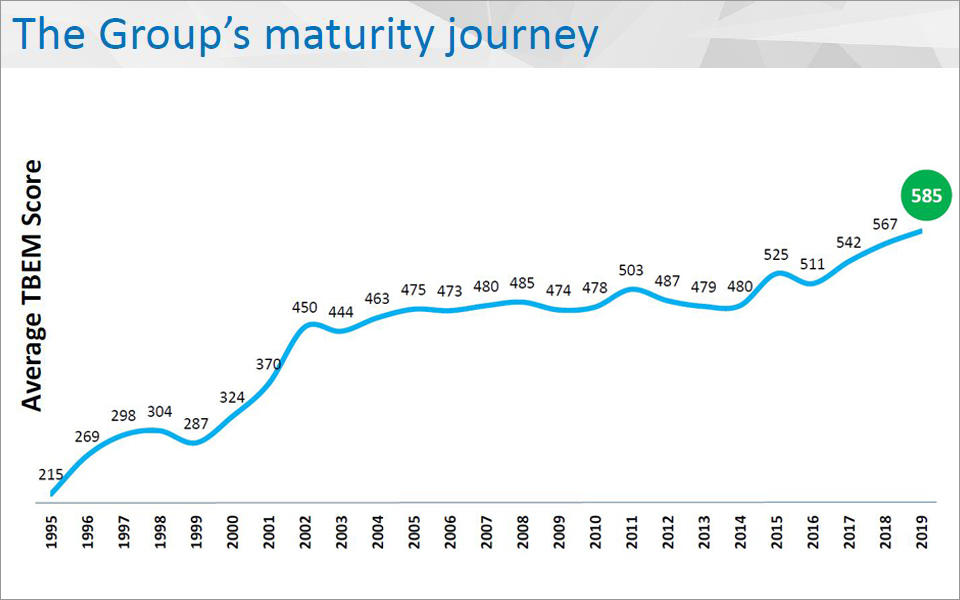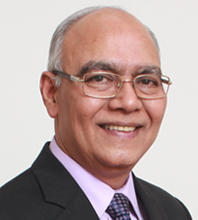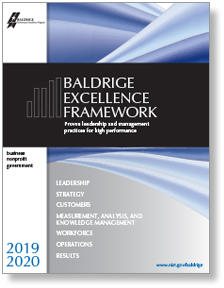Blogrige
The Official Baldrige Blog

What does the continued success of a 150-year-old, multisector, multinational organization headquartered in India have to do with the Baldrige Excellence Framework?
In the early 1990s, the then-chairman of the Tata Group, Ratan Tata, created the Tata Business Excellence Model (TBEM). TBEM is based on the Baldrige Criteria for Performance Excellence (part of the Baldrige Excellence Framework), and since 1995, the holding group has conducted internal assessments, like the Baldrige Award process, for its more than 100 companies operating in ten industries: information technology, steel, automotive, consumer and retail, infrastructure, financial services, aerospace and defense, tourism and travel, telecom and media, and trading and investments.
According to Ratan Tata, “The true objective of setting these criteria, however, was never meant to be merely to use them as an assessment for an award but, more importantly, to utilize them for an institutionalized approach to drive performance and attain higher levels of efficiency in everything that a corporate entity does.”
Blogrige authors have written about Tata’s success with TBEM before in "’Making an Elephant Dance’: How the Baldrige Criteria Helped Transform a Global Conglomerate,” “Rediscover an Organization's Potential with the ‘Baldrige Criteria's Power,’" and “Tata’s Baldrige Advantage: A Multinational’s Model for Performance Excellence.”
This success and the company’s use of TBEM continues today.
S. Padmanabhan Shares Some Insights on Using the TBEM

Tata Business Excellence Group
According to S. Padmanabhan (Paddy), who runs the Tata Business Excellence Program, Tata Consultancy Services (TCS) recently was awarded “Iconic Company of the Decade” by India Business Leader Awards, named number one for customer satisfaction by its United Kingdom clients, and named number-one top employer by USA 2020.
Within the Tata group, TCS has been a benchmark leader using TBEM, surpassing a 750-point (combined process and results scoring bands) milestone in its Baldrige-based 2019 assessments. As a comparison, see the 2019–2020 Scoring Band Descriptors (Word) that are part of the Baldrige Excellence Framework.
I touched base with Paddy to see how the TBEM assessment process is working today and how this Baldrige-based model has brought value to the Tata companies.
What is the purpose of TBEM?
The purpose of the model was to have a consistent way “to face up to the significant economic changes being experienced in India specifically and the strong need to compete and excel among the world players,” according to a company presentation. “An institutionalized approach was the need of the hour to bring the hundred+ Tata entities together and become a globally recognized brand through world-class products and services.”
How does the TBEM Baldrige-based assessment work?
For the Baldrige-based, TBEM assessment, every Tata company that is a signatory to a brand agreement has to comply with achieving a total score in process and results items of 500 points within four years of signing the agreement.
According to a company presentation, “Achieving 500 points was [once] considered a difficult task. . . . Within a few years of this being institutionalized, many companies started achieving this milestone.”
Companies that score more than 650 come for assessments once every three years, companies with a score of 500 to 650 once every two years, and those below 500 every year. Tata companies are considered industry leaders with scores of 651 to 750, benchmark leaders with scores of 751 to 850, and world-class leaders with scores over 851, said Paddy.
He added, “This serves the purpose for companies to continue to strive for excellence, as it is a never-ending journey, and even for achievers in the 650+ band, it is important to sustain their performance at high levels.”
Paddy shared a quote from the chief executive officer of a Tata 650+ company,
Some of the key benefits that our company has derived from using TBEM are focus on continuous improvement, process orientation, informed decision making, total picture, and measured risk taking. . . . Benefits have all paid dividends by changing the overall culture of the company. It has changed the organization from being merely impulsive and intuitive to being more informed and process oriented.
According to a company presentation, for the mature Tata companies, “the assessment is a mirror. It gives them an opportunity to benchmark their processes and results and finally recognition and awards at a group level. . . . For newer companies, TBEM is a platform to learn from other Tata companies and improve processes and outcomes.”
Said Paddy, all the five companies in the 650+ band have achieved significant success in their respective industries. “In many ways, the excellence has become a way of life and that is the biggest outcome and embodies the original philosophy of the then-group chairman in introducing TBEM for all Tata companies.”
The TBEM assessment process is entirely conducted by Tata employees, and many companies encourage employees to conduct assessments as a part of their professional development, said Paddy.
“For our employees, it is an aspirational leadership development platform. They get exposure to different industries and companies and an opportunity to interact with the leadership of companies. It is also a great networking opportunity,” he added.
How have you shared learning/best practices across the company?
Paddy said that Tata conducts learning missions to companies within the group and outside the group. Such learning is added to a knowledge portal that has more than 650+ practices covering all areas to address of the TBEM criteria from 50+ Tata companies, and it is available to all companies. In addition, every Wednesday, a webinar by a subject-matter expert is used to share expertise and knowledge; on May 13, 2020, Tata conducted its 250th webinar. Once every two months, a chief executive officer or a C-level executive of a Tata company conducts the webinar.
Paddy said Tata also signed up for enterprise membership with APQC and organizational membership with ASQ for sharing and learning best practices and benchmarking global companies.
What results have Tata companies achieved using the TBEM (Baldrige-based framework) as the basis for excellence efforts?
According to Paddy, Tata companies have progressed despite the changing nature of business, the environment, and the market. He said, based on TBEM assessment scores, the group now has one Tata company as a benchmark leader, four as industry leaders, and twenty-four as emerging industry leaders.
Group revenue was at $113 billion in FY2019, up from $110 billion in FY2018.
“Our companies are becoming mature and striving to benchmark with the world’s best and aim for world-class performance in the chosen metrics,” he said. “This gives us an inspiration to go beyond what we can think of achieving now. . . . The journey is our destination.”
Next steps for the TBEM assessments, according to a company presentation, are to customize engagements with Tata companies to suit an individual company’s context; to ensure data maturity in terms of availability, integrity, reliability, and accessibility; and to continue to explore best practices in the areas of data analytics, artificial intelligence, and the internet of things.
Why do you think excellence matters in today's economy?
“Excellence as we understand it is not a destination at a point in time but a never-ending journey,” said Paddy. “An excellence framework like TBEM helps companies continuously introspect and hence increase the pace of change internally.”
He added that the excellence framework helps companies focus on all key stakeholders and not just shareholders. “The emphasis on customers, workforce, society, and suppliers—apart from the shareholders—ensures balanced strategy, which does not get skewed by short-term focus on quarterly performances and enables companies to think long-term. In today’s times, this focus on the long-term and a balanced stakeholder focus are very crucial for the long-term success of companies.”

Baldrige Excellence Framework
The Baldrige Excellence Framework has empowered organizations to accomplish their missions, improve results, and become more competitive. It includes the Criteria for Performance Excellence, core values and concepts, and guidelines for evaluating your processes and results.
Purchase your copy today!
Available versions: Business/Nonprofit, Education, and Health Care
About the author
Related Posts
Comments
Fantastic story! Straight to the point, interesting, empowering, user friendly, and definatly, englight! Thank you, Ms. Baily, for such a professional and encouraging article amid at, small entities like our organization, Global Economic CDC, Inc. We are constantly seeking such priceless consulting guidence, learning opportunities, and trustees, as you have presented and introduce in your article above. The proven successful iconic leadership, that is the Tata Group, worldwide. Small emerging economic development organizations, such as ours, are constantly seeking, great mentorship opportunities, and partnership programs, like what the Tata Group, and it's highly internationally aclaimed program TBEM, has successfully delivered, over the past three decades . Further, it's branding has solidify it's goals globally, thought the continues perfect leadship, and ethical leader, the honorable Mr. S. Padmanabhan (most lovenly (AKA) "Paddy"). Additionally, I experience while ready this article, gratitute, and the inspiring ability, that our organization can event become unstoppable, most enlighting, successful in all its future endeavors, too. By simply following, and applying, the basic introductions, rules and template pattern, as presented by the Baldrige Program's Manuel, as easily provided to us all. Which I believe is introducing, the excellence opportunity, of acquiring at our finger tips immediately; "the must have", for a successful business role model blue print, the Baldrige Excellence Framework Manuel. See you at the successful finish line, by way of, the Baldrige Program inspiring reconmendation. Thank you, for the opportunity you have given me, to share my experiance, and opinion, of this worthy and timely article, "True Objective: To Drive Performance in Everything".
Very nice article . Tata has always been an inspiration.






Very nice article on the Tata Group’s implementation of the Baldrige model to manage their diverse portfolio of companies. They are truly a global role model for the rest of us!!!